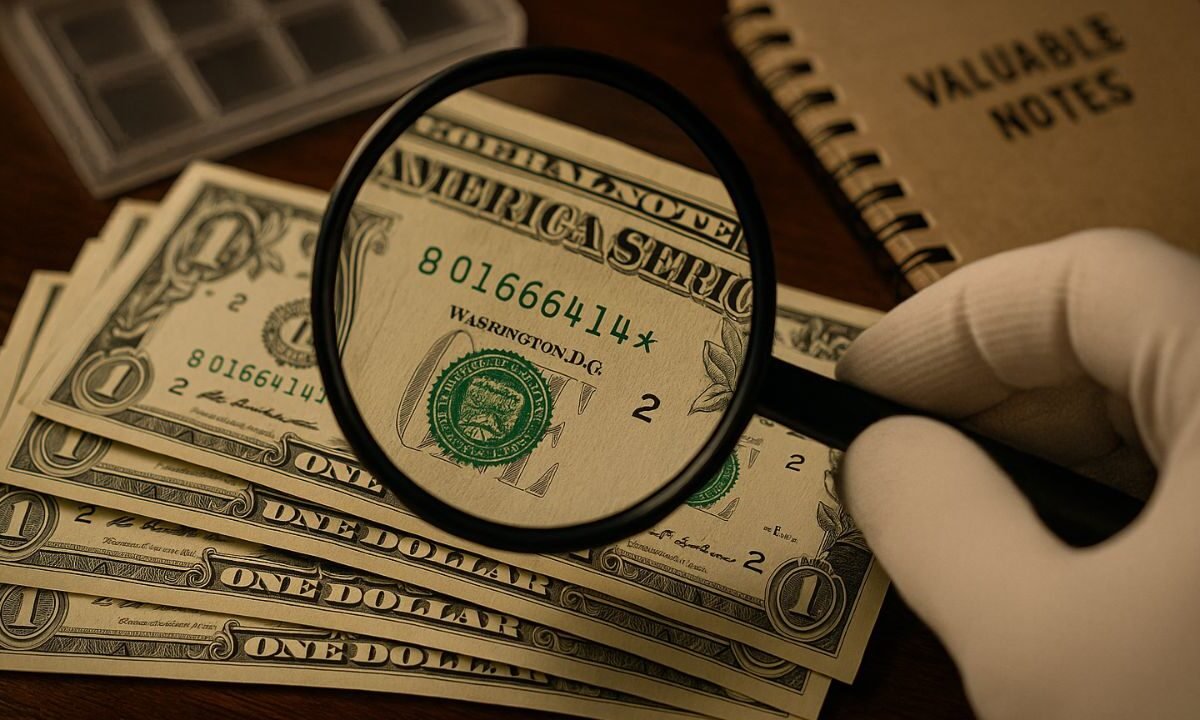Most $1 bills are worth face value—but a tiny fraction carry printing errors or special serial numbers that transform them into high-value collectibles.
The biggest modern headline is the Series 2013 “B” duplicate-serial star notes: a printing bureau mix-up resulted in identical serial-number pairs printed in two locations.
Verified matched pairs have sold well into five figures, with reports of a $25,000 sale for one matched set; grading experts have estimated pairs at $10,000-$15,000 at auction, while mainstream coverage often cites upside “into the $150,000 range” for top-grade, perfectly paired notes.
Beyond that, collectors also pay thousands for major error notes (like inverted or missing overprints, dramatic misalignments, mismatched serials) and for fancy serial numbers (e.g., ladders 01234567, solids 77777777, radars 12344321).
These categories have long auction histories and published price guidance.
The Fast Check- 3 Things To Inspect
- Series & Star: Look for “Series 2013” with a “B” Federal Reserve seal (New York) and a serial number ending in a star (replacement note). Only certain star-note ranges are part of the duplicate-serial error: B00000001★–B00250000★ and B03200001★–B09600000★. If your serial falls outside these ranges, it isn’t one of the duplicated notes tracked by experts.
- Fancy Serial Numbers: Check if your bill has a ladder, solid, repeater, or radar. Top examples in crisp condition are known to bring thousands.
- Visible Errors: Scan for big, obvious printing mistakes—mismatched serial numbers, inverted or missing overprints, foldovers/gutter folds, or severe off-center prints. These “major errors” can command serious premiums.
Quick Value Guide (What Collectors Pay Today)
| Category | What to Look For | Typical Potential Value | Notes |
|---|---|---|---|
| 2013B Duplicate-Serial Pair (Star) | Two matching “B★” notes, one DC and one Fort Worth, within approved ranges | $10,000-$25,000+ documented; media hype up to $150,000 | Verified sale at $25,000; expert estimate $10,000-$15,000 |
| Major Error Notes | Mismatched serials, inverted/missing prints, dramatic misalignment | Thousands to tens of thousands | Rare errors reach five figures |
| Fancy Serial Numbers | Ladders, solids, radars, repeaters, low numbers | Hundreds to several thousands | High grade and condition boost value |
| Star Notes (general) | “★” at end of serial (replacement notes) | Small premium to hundreds+ | Value depends heavily on series, district, range, and grade |
(*Realized prices vary greatly by condition (grade) and market demand.)
How To Authenticate and Sell
- Confirm the range: If you suspect a 2013B duplicate, verify your serial falls in one of the two star-note ranges above.
- Check a trusted guide: Use recognized error-note and serial-number resources to understand rarity and comparable sales.
- Grade it: Professional third-party grading (PMG, PCGS) can boost confidence and price for serious notes/pairs.
- Document provenance: For matched pairs, evidence that one note was printed in Washington, D.C., and the other in Fort Worth—and that they share the identical serial—is key to premium pricing. Verified pair sales are already recorded publicly.
Pro Tips (2025)
- Condition rules: Crisp, uncirculated notes bring multiples of circulated examples.
- Be realistic about “$100,000”: While mainstream stories hype six-figure possibilities for the perfect matched pair, verified sales so far have peaked in the tens of thousands. Exceptional grade, publicity, and auction competition would be needed to approach six figures.
Your everyday $1 bill might hide a big-money secret—especially if it’s a 2013B star note within the duplicate-serial ranges, a dramatic error note, or a bill with a fancy serial number.
Verified sales already show five-figure results for matched duplicate pairs, while top error and fancy-number notes routinely fetch thousands.
Check the series, star, serial, and print—and if yours looks promising, verify, grade, and consign to unlock full value.
FAQs
What exact serial ranges define the 2013B duplicate-serial star-note error?
Two ranges: B00000001★–B00250000★ and B03200001★–B09600000★ (New York “B” district, Series 2013). Only star notes in these ranges are candidates.
Do single 2013B star notes have big value without a matched pair?
Usually no—on their own, a lone note typically brings a modest premium. The huge premiums arise when you can assemble a matched pair (DC + Fort Worth with identical serials) and grade it highly.
Besides the 2013B error, what else can make a $1 bill valuable?
Major printing errors (mismatched serials, inverted/missing overprints, foldovers, severe misalignment) and fancy serial numbers (ladders, solids, radars, repeaters, very low numbers) can all command hundreds to tens of thousands, depending on grade and rarity.

